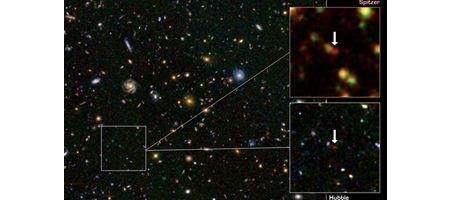Astronomers using NASA’s Spitzer and Hubble space telescopes have discovered that one of the most distant galaxies known is churning out stars at the rate of 100 per year.

The blob-shaped galaxy, called GN-108036, is the brightest galaxy ever found so far off – 12.9 billion light-years away. Its rate of star formation is astonishing, says NASA – by comparison, our own Milky Way galaxy is about five times larger and 100 times more massive than GN-108036, but makes about 30 times fewer stars per year.
GN-108036 is so far away that it’s being observed just 750 million years after the Big Bang, 13.7 billion years ago.
“The discovery is surprising because previous surveys had not found galaxies this bright so early in the history of the universe,” says Mark Dickinson of the National Optical Astronomy Observatory.
“Perhaps those surveys were just too small to find galaxies like GN-108036. It may be a special, rare object that we just happened to catch during an extreme burst of star formation.”
The astronomers were surprised to see such a high rate of star formation, because the galaxy is so small and so early. Back when galaxies were first forming, in the first few hundreds of millions of years after the Big Bang, they were much smaller than they are today.
“The high rate of star formation found for GN-108036 implies that it was rapidly building up its mass some 750 million years after the Big Bang, when the universe was only about five percent of its present age,” says Bahram Mobasher, a team member from the University of California, Riverside.
“This was therefore a likely ancestor of massive and evolved galaxies seen today.”






